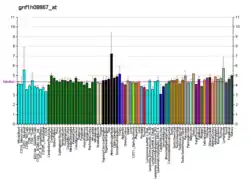Desert hedgehog (protein)
Desert hedgehog, also Desert hedgehog homolog or Dhh, is a protein encoded by the DHH gene, and is a member of the hedgehog signaling pathway. The human homolog (DHH) is on chromosome band 12q13.1.[5][6] The protein encoded by this gene is involved in cell signaling. The several mammalian variants of the Drosophila hedgehog gene (which was the first named) have been named after the various species of hedgehog; the desert hedgehog is honored by this one. The gene is not specific to desert hedgehogs.
| desert hedgehog | |||||||
|---|---|---|---|---|---|---|---|
| Identifiers | |||||||
| Symbol | DHH | ||||||
| Alt. symbols | HHG-3, MGC35145 | ||||||
| NCBI gene | 50846 | ||||||
| HGNC | 2865 | ||||||
| OMIM | 605423 | ||||||
| RefSeq | NM_021044 | ||||||
| UniProt | O43323 | ||||||
| Other data | |||||||
| Locus | Chr. 12 q13.1 | ||||||
| |||||||
Function
This gene encodes a member of the hedgehog family. The hedgehog gene family encodes signaling molecules that play an important role in regulating morphogenesis. This protein is predicted to be made as a precursor that is autocatalytically cleaved; the N-terminal portion is soluble and contains the signalling activity while the C-terminal portion is involved in precursor processing. More importantly, the C-terminal product covalently attaches a cholesterol moiety to the N-terminal product, restricting the N-terminal product to the cell surface and preventing it from freely diffusing throughout the organism.
Clinical Significance
Defects in this protein have been associated with partial gonadal dysgenesis (PGD) accompanied by minifascicular polyneuropathy. This protein may be involved in both male gonadal differentiation and perineurial development.[7]
References
- GRCh38: Ensembl release 89: ENSG00000139549 - Ensembl, May 2017
- GRCm38: Ensembl release 89: ENSMUSG00000023000 - Ensembl, May 2017
- "Human PubMed Reference:". National Center for Biotechnology Information, U.S. National Library of Medicine.
- "Mouse PubMed Reference:". National Center for Biotechnology Information, U.S. National Library of Medicine.
- Kamisago M, Kimura M, Furutani Y, Furutani M, Takao A, Momma K, Matsuoka R (1999). "Assignment of human desert hedgehog gene (DHH) to chromosome band 12q13.1 by in situ hybridization". Cytogenet. Cell Genet. 87 (1–2): 117–8. doi:10.1159/000015376. PMID 10640830. S2CID 2152329.
- Tate G, Satoh H, Endo Y, Mitsuya T (2000). "Assignment of desert hedgehog (DHH) to human chromosome bands 12q12→q13.1 by in situ hybridization". Cytogenet. Cell Genet. 88 (1–2): 93–4. doi:10.1159/000015495. PMID 10773676. S2CID 36364525.
- "Entrez Gene: desert hedgehog homolog (Drosophila)".
External links
- DHH protein, human at the US National Library of Medicine Medical Subject Headings (MeSH)
This article incorporates text from the United States National Library of Medicine, which is in the public domain.






